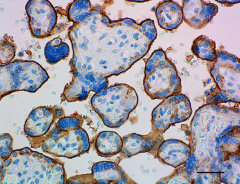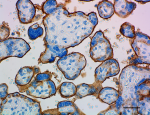- Clone
- 8A11-C11-C9 (See other available formats)
- Regulatory Status
- RUO
- Other Names
- ALPP, PLAA, , Placental Alkaline Phosphatase 1
- Isotype
- Mouse IgG1, κ
- Ave. Rating
- Submit a Review
- Product Citations
- publications

-

IHC staining of purified anti-PLAP antibody (clone 8A11-C11-C9) on formalin-fixed paraffin-embedded human placenta tissue. Following antigen retrieval using Sodium Citrate H.I.E.R (Cat. No. 928502), the tissue was incubated with 2 µg/ml of the primary antibody overnight at 4°C. BioLegend’s Ultra Streptavidin (USA) HRP Detection Kit (Multi-Species, DAB, Cat. No. 929901) was used for detection followed by hematoxylin counterstaining, according to the protocol provided. The image was captured with a 40X objective. Scale Bar: 50 µm -

Western blot of purified anti-PLAP antibody (clone 8A11-C11-C9). Lane 1: Molecular weight marker; Lane 2: 20 µg of human placenta lysate. The blot was incubated with 0.5 µg/mL of the primary antibody overnight at 4°C, followed by incubation with HRP-labeled goat anti-mouse IgG (Cat. No. 405306). Enhanced chemiluminescence was used as the detection system.
| Cat # | Size | Price | Quantity Check Availability | Save | ||
|---|---|---|---|---|---|---|
| 866901 | 25 µg | 85€ | ||||
| 866902 | 100 µg | 221€ | ||||
PLAP is a membrane-bound glycosylated dimeric enzyme that was initially identified in the placenta. PLAP is also known as phospholipase A2 activating protein. Abnormal amyloid beta-induced activation of synaptic phospholipase A2 results in synaptic degeneration due to elevated levels of platelet-activating factor, suggesting that PLAP may be a contributing factor in synaptic damage observed in Alzheimer’s disease patients. Clinically, PLAP is broadly used as a tumor marker, especially in geminoma, seminoma, and ovarian cancer.
Product DetailsProduct Details
- Verified Reactivity
- Human
- Antibody Type
- Monoclonal
- Host Species
- Mouse
- Formulation
- Phosphate-buffered solution, pH 7.2, containing 0.09% sodium azide.
- Preparation
- The antibody was purified by affinity chromatography.
- Concentration
- 0.5 mg/ml
- Storage & Handling
- The antibody solution should be stored undiluted between 2°C and 8°C.
- Application
-
IHC-P - Quality tested
WB - Verified - Recommended Usage
-
Each lot of this antibody is quality control tested by formalin-fixed paraffin-embedded immunohistochemical staining. For immunohistochemistry, a concentration range of 2.0 - 10 µg/ml is suggested. For Western blotting, the suggested use of this reagent is 0.5 - 10 µg per ml. It is recommended that the reagent be titrated for optimal performance for each application.
- RRID
-
AB_2810793 (BioLegend Cat. No. 866901)
AB_2810794 (BioLegend Cat. No. 866902)
Antigen Details
- Structure
- PLAP is a 795 amino acid protein with predicted molecular mass of ~87 kD and observed molecular mass of ~70 kD.
- Distribution
-
Tissue Distribution: Ubiquitously expressed
Cellular Distribution: Plasma membrane - Function
- Phospholipase A2 activating protein that may be involved in amyloid beta-induced synaptic degeneration.
- Interaction
- Ubiquitin, UBXN6, VCP, YOD1
- Cell Type
- Astrocytes, Endothelial cells, Neurons
- Biology Area
- Cancer Biomarkers, Neurodegeneration, Neuroscience, Synaptic Biology
- Molecular Family
- Protein Kinases/Phosphatase
- Antigen References
-
- Watanabe S et al., 2012. Pediatr Neurosurg. 48(3):141
- Bate C et al., 2010. Mol Neurodegener. 5:13
- Huynh ML et al., 2011. Genesis. 49(11):851
- Gene ID
- 18786 View all products for this Gene ID
- UniProt
- View information about PLAP on UniProt.org
Related FAQs
Other Formats
View All PLAP Reagents Request Custom Conjugation| Description | Clone | Applications |
|---|---|---|
| Purified anti-PLAP | 8A11-C11-C9 | IHC-P,WB |
Compare Data Across All Formats
This data display is provided for general comparisons between formats.
Your actual data may vary due to variations in samples, target cells, instruments and their settings, staining conditions, and other factors.
If you need assistance with selecting the best format contact our expert technical support team.
 Login / Register
Login / Register 









Follow Us